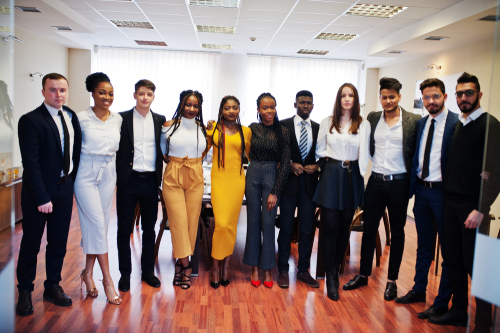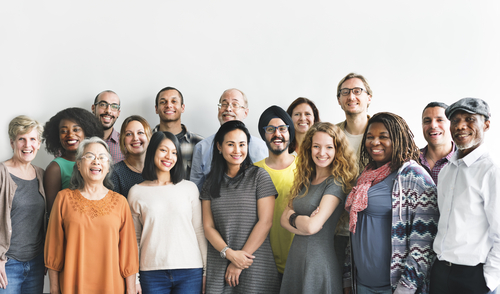How do you define workforce diversity? The workforce diversity definition is an important concept that helps businesses appeal to a wider variety of customers and workers. However, it can be very difficult to transition from idea to practice. This concept is so important for businesses to understand. A diverse and inclusive workplace is important in the workplace.
Diversity in the workplace means much more these days than in the past. Genders, religious belief systems, race ethnicity, sexual orientations, degrees of ableness (physical abilities and disabilities), and other categories are all currently recognized and must be accommodated.
Related Resource: 20 Companies With the Best Benefits
What It Means And Entails
What is the workforce diversity definition? A diverse workforce simply means a company has built a diversified workforce that includes many different types of people. Diversity in the workplace can mean people of different ethnicities, sexual orientations, socioeconomic statuses, ages, genders, religions and other ways in which humans innately differ. It can also simply mean people who have different personalities and will approach situations differently. For example, include both introverts and extroverts. It is important for people to understand the workforce diversity meaning so that, ideally, an organization will build a workforce consisting of all of the above. It is also important to match its strategy for having diverse employees by implementing diversity and inclusion with its overall organizational goals and values. That is the definition of a diverse workforce.
Possible Characteristics of Employees
Gender
Gender is no longer a dichotomy. There are many genders. Some people identify as one gender while expressing themselves as another. Gender is different than biological sex. Some key terms to know are “assigned female at birth,” or AFAB, and “assigned male at birth,” or AMAB. People can identify as any gender even if their gender differs from their sex. This is also referred to as “who you are when you get into bed.”
Sexual Orientation
Sexual orientation involves the concept of “who it is with whom you would get into bed.” Attraction comes in two flavors: sexual and romantic. It’s possible for someone to be romantically attracted to one gender while being sexually attracted to a different gender. Some people are even asexual, or ace. Pansexual people are attracted to all genders equally. For more information about gender and sexual orientation, see the Genderbread Person, version 4.0. It’s a concise and practical way to highlight the different ways gender and orientation can be expressed.
Race
Race involves a couple different factors. One factor is melanin concentration in the skin. Another factor is a country, or area within a country, from which a person hails. Like the gender dichotomy, the concept of race is a social construct as human beings became tribal. Each person identifies with and expresses race in a certain way.
Ethnicity
Ethnicity involves the cultural aspects of people’s lives. More than just “where they’re from,” it encompasses the traditions of people with similar backgrounds. Music, food, dance, and “rules to live by” are all examples of the shared culture of people with similar histories. Considering race ethnicity is just one part of workforce diversity
Religion
People’s religion is their belief system, or lack of belief system, in a higher power of some sort. There are many, many more religions in the world than simply the Abrahamic faiths. Religion is also a subset of culture and ethnicity. There are many religions that have very few followers. Still in the U.S., where religious freedom is a cornerstone of the founding of the country, all people have the right to worship, or not worship, as they see fit.
Age
Age is simply how old someone is.
Physical Abilities/Disabilities
In the U.S., it is not legal to use a person’s physical ability, or lack thereof, or the person’s disability, if any, as a qualification for employment. The exception to this rule is if the job requires a specific set of skills and capabilities, physical or otherwise, and the person is not capable of fulfilling the job’s requirements. An example would be, you couldn’t refuse to hire someone with only one leg to work in an office job because of the missing leg, but you could say, “No,” to the person for a job as a high steel beam worker.
Life Experiences
Workforce diversity also means that many people will have had many different paths through life. Some might have served in the Army. Some people might have had a dozen jobs before. Some might have had only one job.
Socioeconomic Background
This is merely how rich or poor you were in the past.
Employee Engagement
Different people will apply themselves to differing degrees in the job. Because some of these people might have various health or other issues that prevent them from applying themselves equally, this should not be a concern.
Political Beliefs
People’s political beliefs are irrelevant to how they perform assorted job functions. As long as those beliefs don’t violate the rights of others, they also shouldn’t be relevant in hiring or promoting someone.
How Does Workforce Diversity Impact a Business?
- Improves Company Performance: Improving diversity in the workplace is crucial to improving performance. People who feel respected and at ease will outperform people who are stressed and disrespected.
- Improves Employee Engagement and Retention: Employees who feel appreciated and empowered remain more loyal than those who are treated shabbily. A diverse and inclusive workplace delivers that.
- Improves Public Perception of Your Brand: If a company is public with its diversity strategy, then it will build its image among aware people. This will help it grow.
- Promotes Creativity, New Ideas, and Perspectives: Because of their different perspectives, different backgrounds, and cultural experiences, a diverse workforce helps keep a workplace from becoming stagnant. A stagnant workplace brings poor results. Stagnation brings about discontent. A vibrant, creative workplace with different perspectives builds camaraderie and esprit de corps.
- Creates a Better Understanding of Target Demographics and What Drives Them: Members of a diverse workplace understand people of similar backgrounds as they have want in both the products and services they buy and the companies from which they buy them.
- Aligns an Organization’s Culture With the Demographic Makeup of America: When people in a diverse workplace feel as if they identify closely with their clientele, then they can use their own experiences and understanding to assess the American people’s preferences accurately. The culturally diverse workplace is a cross-section of the U.S. as a whole.
- Improves Customer Satisfaction by Improving how Employees Interact With a More Diverse Clientele: By improving how employees interact with a more diverse clientele, customer satisfaction will improve. People of the global majority, in other words nonwhite, will appreciate a company that tailors its presentations and brand to them and respects not only themselves but also their culture and history. A diverse workforce will know how to work with these folks to make their experience as good as possible.
How Do You Create Diversity in the Workplace?
The first step to building a more diverse workforce is simply hiring employees from different backgrounds. Companies should not mistake tokenism for diversity. Tokenism is where they hire a single person from one group while all of their other employees are from another group. This is not only unhelpful but it comes across as shallow and likely will lead to disgruntled employees. Integrate a hiring strategy with overall business objectives. For example, hiring employees from a specific group may help the company be successful in particular business ventures, such as expanding into a new area or offering a new product. As Forbes notes, a diverse workforce can be difficult to achieve. It is important for companies to learn from their mistakes and keep trying.
Creating diversity in the workplace involves tearing down centuries of bigotry and stereotyping. Qualified people for each job could have any combination of characteristics other than a white, straight, cisgender male. Companies that are either stuck in the Dark Ages or that embrace the values and characteristics of those times must completely change their mindset as well as their culture.
They must hire only based on ability to do the job. They must cast aside nepotism, “favors for friends,” and every other thing that creates bad feelings among workers and management alike. Most of all, they have to start to put their employees first. An increasingly diverse and savvy public is not standing for Dark Ages mentality any longer. In order to embrace workplace diversity, companies should make sure that:
- The HR team is aware of diversity hiring goals. If these folks don’t know whom the company wants to hire, then they can’t hire the right people.
- Diversity policies are outlined in the employee handbook. There should be no cases of, “I didn’t know,” when it comes to workplace diversity. Each employee should know the company’s stance on diversity while reading the handbook.
- There is a code of conduct. Employees and management personnel alike should follow a strict code of conduct while embracing and enforcing workplace diversity.
- There is a nondiscrimination policy. This policy should align with federal law regarding protected groups and the prohibition against discriminating against these groups. This includes not only hiring people but also evaluating them, managing them, and promoting them within the company.
- There is a compensation and benefits policy. No one should receive different pay simply for being different than others. The pay and benefits outlined in the employee handbook should be equal for all people performing the same duties.
- Employment conditions and termination are clear. All people should be safe while at work and while performing the jobs they are assigned. They should not be fired for any reason relating to who they are. This goes back to the nepotism concept, too. No one should be let go to make room for “the boss’s nephew.”
- Your company is an equal opportunity employer. This ties in with the nondiscrimination policy. Every person who applies should have the same opportunities as every other person in the company, without exception.
- There is a clearly defined zero tolerance policy. This means also that violations of the policy are dealt with swiftly and fairly. Having a policy and not enforcing it is worse than have no policy at all.
- Employees are aware of diversity policies and that they have an open door of communication to report any diversity issues. Confidentiality goes along with the open door. There must be no reprisals against anyone making a good-faith report of diversity failures.
- Employees engage in sensitivity training. Not everyone is as aware as others regarding diversity. Education is key.
- The company stays current with diversity laws. Laws change. A company that keeps its eyes and ears open won’t be caught unawares.
- There are opportunities to create team building activities based on the interests and abilities of employees. This ties in with the concepts of camaraderie and esprit de corps. Happy employees are productive employees.
- The company has benefits that attract more diverse employees:
- Floating holidays, such as Rosh Hashanah, Yom Kippur, Ramadan, the various solstices, and other holidays that are important to other religions
- Working remotely, which can accommodate people who might have trouble getting to the office because of a disability
- Flexible work schedules for people who study, have children in school, and other things that would interfere with the now obsolete 9-5 workday
Creating a diverse workplace is not difficult. It just takes time and energy and is well worth it.
Related Resource: Is an HR Degree Worth It?
The Advantages Of A Diverse Workforce
Working to create a diverse workforce has numerous advantages for companies. Diverse workers are going to come up with more varied, unique approaches and ideas. This allows a company to better innovate and come up with more creative ideas. A workforce consisting mainly of one group is more conducive to creative stagnation. This can halt a company’s success in its tracks. Having employees who speak different languages opens up international business opportunities. It can also help with outreach into communities at home where other languages are spoken. A diverse workforce improves a company’s reputation. This allows it to attract better talent and more customers.
Supporting Diverse Employees
Creating a diverse organization does not just end with hiring employees of different backgrounds. The company needs to support them and meet their unique needs. For example, a member of a religious minority may grow dissatisfied when they are either not allowed to be off work on their holidays or has to ask time off to practice their religion while other employees do not need to work on their religious holidays by default. An employee of a different ethnicity may experience unaddressed racism and opt to leave. Companies need to take their commitment to a diversity workforce seriously so that all will be welcome. When companies do, they reap the benefits in lower turnover and stronger loyalty from both employees and customers.
America and the world continue to grow more diverse and globalized. Companies need to keep up by representing and appealing to different types of people. Continue to ask yourself, “What is a diverse workforce?” because workforce diversity is a powerful strategy companies can leverage for their benefit and the benefit of others.
Related Resources:





